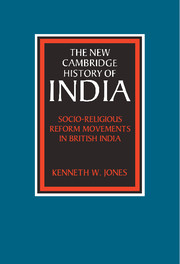Book contents
- Frontmatter
- 1 Concepts and context
- 2 Bengal and north-eastern India
- 3 The Gangetic core: Uttar Pradesh and Bihar
- 4 Punjab and the north-west
- 5 The central belt and Maharashtra
- 6 The Dravidian South
- 7 The twentieth century: socio-religious movements in a politicized world
- 8 Conclusion: religion in history
- Glossary of Indian terms
- Bibliographical essay
- Index
- THE NEW CAMBRIDGE HISTORY OF INDIA
- References
2 - Bengal and north-eastern India
Published online by Cambridge University Press: 28 March 2008
- Frontmatter
- 1 Concepts and context
- 2 Bengal and north-eastern India
- 3 The Gangetic core: Uttar Pradesh and Bihar
- 4 Punjab and the north-west
- 5 The central belt and Maharashtra
- 6 The Dravidian South
- 7 The twentieth century: socio-religious movements in a politicized world
- 8 Conclusion: religion in history
- Glossary of Indian terms
- Bibliographical essay
- Index
- THE NEW CAMBRIDGE HISTORY OF INDIA
- References
Summary
THE SETTING
The first region under consideration is Bengal and its adjoining territory of Assam in the North-East. Bengal proper is a huge delta built up by the combined river systems of the Ganges and the Brahmaputra. Bengal and its environs are ringed by mountains in the North and East, by the bay to the South, the hills of Orissa and Chota Nagpur to the South-West, and Bihar to the West. Divided by numerous rivers and consisting of swampy land with abundant rainfall, Bengal was developed late in the history of South Asia and remained at the edge of Hindu-Buddhist civilization. Eastern Bengal, Assam, and the hill tracts bordering Burma marked the end of one major civilization and the beginning of the South-East Asia cultural sphere.
The incorporation of Bengal into the expanding culture of north India brought with it Sanskrit, Hinduism, and the caste structure. Brahman priests ascended to the foremost position in society, but never with the same degree of dominance as in the central Gangetic Plain or in south India. The Kshatriya (warrior) and Vaishya (merchant) castes were absent. Instead two smaller groups, the Kayasthas, a writer-clerk caste, and the Baidyas, once physicians and later landlords, marked the next levels below the Brahmans. Thus the mass of Bengalis were classed as Sudras or peasants; beneath them were the untouchables. Within this region Buddhism and, to a lesser degree, Jainism provided a longstanding challenge to Hinduism. In the surrounding hill tracts, the high civilization of the valleys and the delta faded away. Many of the tribes within the jungles and highlands had their own languages, deities, social structures, and tribal culture.
In the first decade of the thirteenth century, the Hindu-Buddhist world of Bengal was significantly altered by Islamic conquerors. The establishment of Muslim rule cut ties of political influence and economic support between Hinduism and the state. Over the centuries Islam also changed the socio-religious composition of Bengal through conversion.
- Type
- Chapter
- Information
- Socio-Religious Reform Movements in British India , pp. 15 - 47Publisher: Cambridge University PressPrint publication year: 1990

